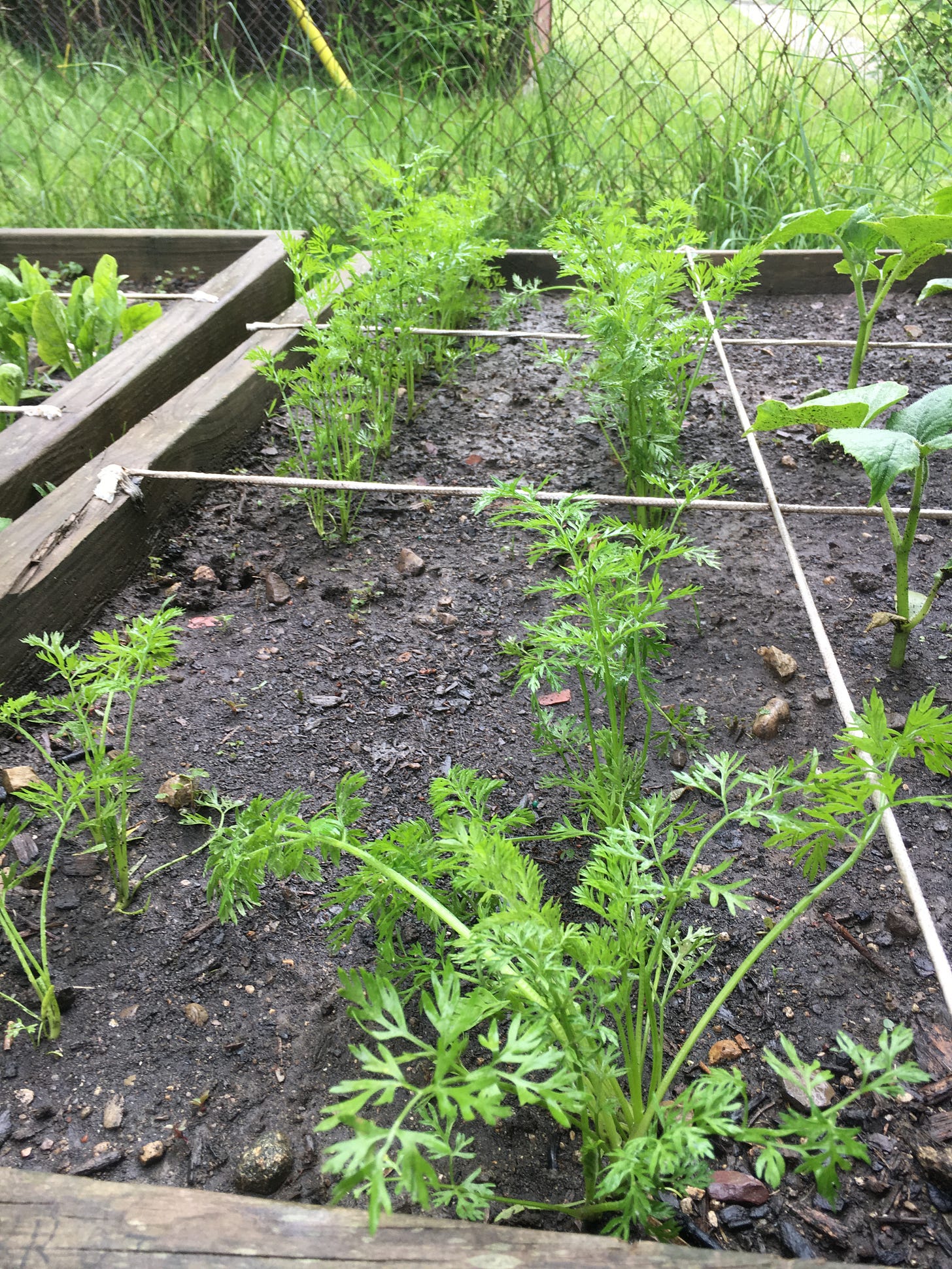Maximizing Yields with Companion Planting and Square Foot Gardening
how to combine two well known gardening techniques
We used the Square Foot Gardening method to plan our very first garden (that was more than a few containers on a stoop). We applied the method to our first in-ground garden on our current homesteading property too. I have a nostalgic spot in my heart for those gardens, broken into grids with string. While our garden has grown and evolved a ton since those days of measuring foot by foot and stringing the space into a grid, those gardens laid the foundation of our gardening knowledge.
That first garden which we used the Square Foot Gardening method consisted of four raised beds (pictured above). It was a small space, which helped to reign us in and prevented us from being totally overwhelmed. We grew zucchini, peas, green beans, tomatoes, herbs, lettuces and carrots. I still remember the day I plucked those first carrots out of the garden. I rubbed one on my shorts and ate it immediately. Dirt and all.
And that’s how I view the Square Foot Gardening method. A foundation. This post is going to pair it with companion planting, to show how the two can work together to maximize growing space and yields.
Square Foot Gardening
The Square Foot Gardening method is a trademarked system for gardening where gardens are broken down into squares, each one square foot in area (in case that wasn’t obvious). Each square is traditionally assigned to one type of plant. The Square Foot Gardening Foundation has prescribed the optimal number of plants for each crop per square. For example, a tomato is planted one plant per square. Carrots can be planted six plants per square. Leaf lettuces can handle sixteen plants per square.
Benefits of Square Foot Gardening
What are the biggest benefits of any gardening method? Less work, less water, less weeds, more yield.
The Square Foot Gardening method can be used in any garden by segmenting the space into squares, but the trademarked method is done in raised beds. This is where the “less work” and “less weeds” claims come in. Once beds are built and filled the work is pretty much done. We have raised beds in our garden that take up about 50% of our growing space. It was a lot of work to plan, build and fill them, but they’re definitely less maintenance than our in-ground gardens. Each spring we have to redefine rows, apply a ton of mulch and some compost to our raised row in-ground garden. Our raised beds get some weeds, but they’re usually the kind that pop right out, tap root and all. I believe these claims to be from the raised beds, not the planting technique, but make of it what you will.
The Square Foot Gardening method can claim less water because more of the soil is covered by planting more intensively. Covered soil retains moisture better than bare soil. It’s common sense - bare soil is exposed to the sun and will dry out more quickly than soil covered in foliage. The trademarked method also has a special soil mix to fill their beds that contribute to this claim as well.
More yield? It’s a little misleading. Yes, you can get more out of your garden using the Square Foot Gardening method. I say it’s misleading because you get more yield due to the simple fact that you have more plants in your garden. This isn’t a magic trick (like some gardening methods).
We’re lucky enough to be urban AND have acreage at our current homestead. That wasn’t the case in the first garden I mentioned earlier. Four raised beds. That’s it. I don’t have a record of all that we produced but we had a diverse selection of plants overflowing from those raised beds because we followed the Square Foot Gardening method. It was a successful garden, and as foundational as the method was in teaching us basic gardening techniques, it created a foundational love for gardening as well. Now as a homesteader with goals of filling our pantry for winter consumption, quantity is more important than ever. The principles of Square Foot Gardening help me plant intensively and maximize soil coverage even if I’m not planting in squares per se.
Companion Planting
The concept of companion planting, popular among permaculture gardeners, is when two or more different plants are grown in the same spot. Companion planting is something that we introduced to our garden a few years ago. The initial planning was hard, but I was thinking about everything very scientifically. In fact, companion planting isn’t scientifically proven (with quantitative evidence) to be beneficial. It is, though, heralded by hundreds of years of gardeners for it’s ability to reduce pests, attract pollinators, and even with certain pairings, help increase flavor and nutritional content of crops.
Over the last few years of using companion planting in our garden, I’ve noticed that we water less (due to the soil being covered more), have more pollinators (which is so fun for Aurora (and soon Durham) to see), and less pest damage from insects and small mammals (those dang deer still come around the corn).
The remaining post is for paid subscribers and outlines how to easily combine these two quintessential gardening concepts to get maximum benefits in your garden.



